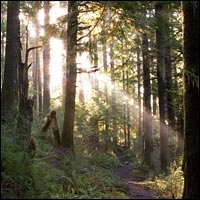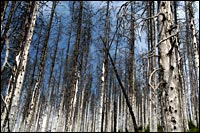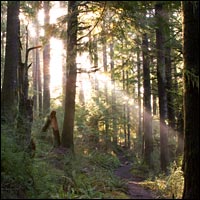In 1982, Earth First!er Dave Foreman used form letters to blitz the U.S. Forest Service with administrative appeals, blocking over 100 timber sales that threatened roadless areas in several Western states.

There’s a new ray of hope among forest activists.
Photo: iStockphoto.
This act of paper monkeywrenching sums up the relationship conservationists had with the Forest Service for three decades. We attempted nearly every act of peaceful hostility — appeals, lawsuits, tree-sits — to obstruct what was then the largest single agency in the federal government and the largest single employer in many rural communities. The Forest Service was destroying our old-growth and wild areas; it had to be stopped.
That was then. This is now.
Today the Forest Service is broken and demoralized, with a budget built more around firefighting than logging. The annual logging cut is a fraction of what it was in its heyday. Biodiversity is threatened less by the prospect of new roads and clear-cuts in wild country than by the ailing condition of old roads and tree plantations.
The conservation movement is reinventing itself to partner with old nemeses, the timber industry and rural Western communities, to give the Forest Service new life and a new mission to face the challenge of the next 30 years: restoring to ecological health America’s federal forestlands.
Retreat or Regroup?
Anyone looking for signs of the death of environmentalism might think they found pay dirt in the wilderness/forest protection movement. The administration of George W. Bush has left skid marks on our backs as it’s stripped away Clinton-era gains, such as the roadless-area policy and parts of the Pacific Northwest’s old-growth protection plan. Passage of the Healthy Forest Restoration Act of 2003 seemed at the time like the greatest defeat of public-lands conservation since John Muir’s heartbreak at Hetch Hetchy. The dream for a multistate Big Wild legislative agenda now has no voice. Our flagship intellectual magazine, Wild Earth, folded in 2004.
But what looks like full-scale retreat disguises a regrouping. New ideas and strategies are fomenting that are a better fit to modern challenges.
The remarkable new buzzwords on our federal forests today are collaboration and restoration. Fewer hands swing sticks to beat the Forest Service out of old growth and roadless areas. More hold carrots to encourage a future mission of restoring forests damaged by a century of abuse. The effect is stunning:
- On Oregon’s Fremont National Forest, a new plan to restore Ponderosa pine forests on the Lakeview Federal Stewardship Unit was worked out entirely by collaboration among key stakeholders.
- In Alabama, a new generation of Forest Service manager gives a courtesy call to WildLaw’s Ray Vaughan before deviating from landscape-scale restoration plans.
- The Gifford Pinchot National Forest, in the Washington Cascades, has shifted from clear-cutting old forests to thinning plantations, as conservationists work with rural leaders and timber reps to design mutually beneficial restoration projects.
- On the Colville National Forest, in northeastern Washington, conservationists and timber interests are going beyond collaborative design of stewardship projects (to thin dry forests and reduce fire risk to communities) and are steadily negotiating land-use allocations including — wait for it — designated wilderness.
- On Arizona’s Apache-Sitgreaves National Forest, the massive White Mountain Stewardship Contract enjoys across-the-board support. The Center for Biological Diversity engaged early, as soon as the Forest Service had sworn off cutting big trees or outside the wildland/urban interface.
- Conservation and timber leaders are collaborating on a restoration assessment for the entire southern half of New Mexico’s Gila National Forest, including development of infrastructure to sustain a restoration-based economy. The project has brought almost $3 million to local communities.
The list of groups engaged in collaborative restoration reads like a “who’s who” of old warlords: The Wilderness Society, Center for Biological Diversity, The Lands Council, Conservation Northwest (formerly Northwest Ecosystem Alliance), Gifford Pinchot Task Force, WildLaw, Kettle Range Conservation Group, and Cascadia Wildlands Project.
Not everyone is on the bandwagon, however. Michael McCloskey, former executive director of the Sierra Club, recently griped to the Christian Science Monitor that collaboration comprises “a lot of talk and little follow-through.” Similarly, a Seattle activist advised a listserv discussion, “Agreeing to agree with ranchers or loggers or second-home developers seeking federal land entitlements has not worked very well, so far.”
There remains enough bad news to whet such cynicism. Southwest Oregon is still at loggerheads over salvage after the Biscuit fire and efforts by the Bureau of Land Management to ramp up old-growth logging by opting out of Clinton’s Northwest Forest Plan. Nothing has changed in northern Idaho, where one would sell fewer seats to a logging collaboration than to an NFL referee appreciation night in Seattle. There are still strongholds of unreconstructed timber beasts within the Forest Service and BLM.
Nonetheless, the new trend is clear.
Chinese Handcuffs
This trend shows acceptance of new times and new needs on our national forests. Thanks to a higher threshold of science and trust, conservationists are starting to accept logging to address forest issues like these:
- Many second-growth stands of dry forest (Ponderosa pine) are overcrowded and stressed due to decades of fire suppression, high-grade logging, and cattle grazing. Evidence mounts that thinning of small-diameter trees can improve ecological conditions and reduce the risk of undesirable types of fires.
- Some stands of rare old-growth Ponderosa pine are, due to fire suppression, overgrown with competing small trees. Fires that would previously have been beneficial could currently be fatal. Careful thinning of these stands to help restore natural fire regimes may be the only hope.
- Second-growth plantations on the wet, west side of the Cascades can be thinned to accelerate development of old-growth habitat conditions needed to recover the northern spotted owl and other species.
Restoring front country is a necessary ecosystem complement to protecting backcountry. We know that in most regions there is not enough roadless country and old growth remaining to sustain the species, ecosystems, and watershed values we care about. Let’s help create more! Restoring low-elevation forests may in time have a bigger biological payoff than completing our mountaintop wilderness agenda.
Moreover, conservationists don’t have to choose between roadless areas and restoring forests, as the opportunity exists to have both. Like Chinese handcuffs, the curious novelty from which you can only extract your fingers by trying less, a focus on active logging of the front country can bring about protection of backcountry. This is due to the shrunken state of the Forest Service and to federal belt-tightening. The agency is so weakened and constrained that most ranger districts have not the means to simultaneously advance bad timber sales and good restoration projects. When we engage on the ground with our local foresters and help them to understand our vision, the result is not just improvement of specific projects, but also the focusing of scarce agency resources that might otherwise be misspent on clear-cuts. In this process we enable a new generation of better land managers to perform, succeed, and ascend to leadership.
The best hope for conservationists in steering the restoration ship is to have a hand on its rudder. If we instead leave the steering to others, they will guide it toward the shoals of controversy. For instance, I believe that logging at upper elevations, such as lodgepole pine forests, destroys vital wildlife habitat and does not reduce the spread of insects like mountain pine beetle. We should steer the work toward the lower-elevation, drier forests for which scientific consensus is emerging.
At the risk of carrying the sailing analogy too far, the collaborative approach also is resilient against changing political winds. Rural communities are tired of the boom-and-bust cycles of Republican governments and the raw commodity economy. Collaboration, assisted by the experience of community forestry groups and other allies, represents a vital center that can provide quality, long-term work.

Enviros should push to thin overgrown stands before they get charred.
Photo: iStockphoto.
Similarly, post-fire salvage logging is another boom-bust cycle that collaborative restoration can help us avoid. Since conservationists strongly disagree with the view that post-fire logging benefits the land, we need to get better at advocating for restoration logging before the fire. When our voice is silent on the latter, we leave a vacuum that is irresistible to politicians like Reps. Greg Walden (R-Ore.) and Brian Baird (D-Wash.), who are promoting a bill to expedite post-disturbance logging under the guise of restoration. The more we engage in active restoration, the less vulnerable we are to the vagaries of wildfire and salvage politics.
A Battle for Our Soul
Our only hope for meeting the challenge at the scale of restoration needs is through active partnering with timber and community interests.
Together we must battle for the soul of the Forest Service. It cannot restore our forests as a broken institution. But with full and active support of conservation groups and communities, perhaps it can regain its lost esprit de corps to become an institution that would make Teddy Roosevelt proud.
There is no other way.
In this age of Bush’s outrageous debt, we will not see congressional appropriations sufficient to provide meaningful restoration of forests and watersheds. The $10 billion needed to remove or fix bad federal logging roads is not going to ride in from yonder. Oregon’s Siuslaw National Forest can’t even get enough appropriated dollars to prepare popular and profitable restoration thinning projects above a scant 20 million board feet per year. By partnering with the Forest Service, we can improve its chances of getting funding for the needed work.
The Forest Service is also critically hampered by process. This is not because the National Environmental Policy Act requires the agency to publish a library even for timber projects that warrant no public concern. It is because we noble conservationists, during 30 years of defense of our wild country, pummeled agency bureaucrats into thinking that’s what NEPA requires. A lot of paperwork that is necessary when a federal agency proposes to harm the environment is not necessary for beneficial projects.
Red tape should not get in the way of protecting the environment. Conservation groups must demonstrate this or suffer the consequences. If we want our forest ecosystems restored, we must now disabuse the Forest Service of the inefficiencies we helped to impose. We must rescue the Forest Service by becoming its friend, its ally, and its core constituency.
“Naive!” will cry the faithful. “Won’t this restoration agenda and resurrection of the Forest Service aid and abet the timber industry, our sworn enemy?”
Yes. But so it must be. For this is also a battle for the soul of the timber industry. There remain a few unreconstructed timber beasts, but we have better options than directing our attention solely at them.
We restore our forests by partnering with forward thinkers in the timber industry, of which there are plenty. There are mill owners who invested in capital-intensive equipment that can only process small logs. Their survival and success depend on us laying down the mighty pen of appeals to help lay out good timber sales. Just a few years ago, Duane and Russ Vaagen, the second and third generations of Vaagen Brothers Lumber Inc., in Colville, Wash., would hire buses to cram public meetings in their push for federal clearcuts. Times have changed. At a congressional field hearing this past August, Duane and I endorsed one another’s testimony in front of a small, respectful audience.
Your local timber executive has plenty of headaches. His product is undercut by technology that allows wood applications to be beautifully served by bamboo ground into chips and glued back together. His market is undercut not just by cheap wood and wood surrogates from the Third World and by Canadian subsidies, but also by the effects of global warming, like the flood of salvaged bug-kill from British Columbia and hurricane-kill from the Gulf Coast. His access to federal timber is limited by the dysfunctional Forest Service described above and by conservationists that need to take a fresh look at the situation.
Does that mean we can trust him to properly carry out the restoration needs of our federal forests? In theory, no. There will always be incentives that run contrary to conservation interests.
But in actuality, we have little choice. The needed restoration work will not happen without us investing ourselves. Like any investment, this one involves risk. The risks are unlikely to be the ones we are accustomed to, like new roads (too expensive, irrespective of the fate of the roadless policy) or old-growth cutting (the big equipment needed is rusting away). Instead new threats will emerge, from biofuel plants run amok to slipshod restoration work done at least cost by foreign host worker contractors that amount to modern slave-traders. But we must turn toward the risks in the way our predecessors, from John Muir to Dave Brower, turned to face theirs.
Genuinely engaging in collaborative restoration need not equate to unilateral disarmament. We are all adult enough to know that conflict and litigation will continue, though hopefully at reduced levels. A collaborator needs to be more judicious and thoughtful in the use of appeals and lawsuits, but still keep them as potential tools that may even help sustain the incentive for collaborative work.
Biocentrism Is Not Just for Poets
This article commits identity theft. Here I challenge the conservation movement to give up its self-image as sole stewards of the light, gatekeepers to a new and better philosophy of life. This orthodoxy — druid activists preserving wildlands; holy work done by holy people guided by holy doctrine — is limiting. The Deep Ecology movement stalled by claiming as exclusive to itself a land ethic that had (and still has) the prospect of connecting with bedrock American values.
Disclosure: I was brought reluctantly into the fold of community collaborative restoration. A defining moment for me occurred in a volunteer fire hall in southwest Washington in which each of us, being a diverse group of so-called stakeholders, articulated our 100-year vision. The words of John Squires, a local woodcutter, steelhead fisher, and third-generation native of rural eastern Lewis County, resonated for me in ways that Deep Ecology poets never had:
“I dream of a day when salmonids inhabit the Cispus and Cowlitz basin in numbers even greater than I remember as a young kid. I dream the forest we all love will have survived pollution and encroachment from nearby urban areas, and global warming. The forest will have intact, functioning ecosystems and support a wide variety of species.”
That dream will not be fulfilled without community-based collaboration to promote active restoration. That restoration will not occur without the calloused hands of skilled workers like Squires. And the schools in John’s town will not stay open without the wood and jobs generated by that restoration.
I want to be in common cause with John Squires. I want his community to prosper through the restoration of front-country forests that complement the roadless wild country we can be so proud of having already protected. The World Wildlife Fund estimates that more than 2.3 billion board feet can be thinned, without touching a single tree more than 80 years old, from BLM lands in western Oregon alone.
We have at hand an opportunity — brought about by the successes of our lawsuits and campaigns, by the advance of new science, and by the vagaries of changing technologies and markets — to build a new conservation movement and a new Forest Service to advance a new central idea of restoration.
Our emerging conservation movement has the boldness to partner with old enemies and collaborate with communities we never before trusted, and that haven’t trusted us. It has as its goal the conservation of ecosystems that have not only wildlands at their core, but restored productive forest habitat surrounding that core. It runs campaigns that, instead of polarizing rural communities and burning through whatever equity remains in the political capital of conservation, can bring communities together around a common agenda.
The opportunity awaits us. The question is whether we, as a movement, have the courage to say “yes.”


